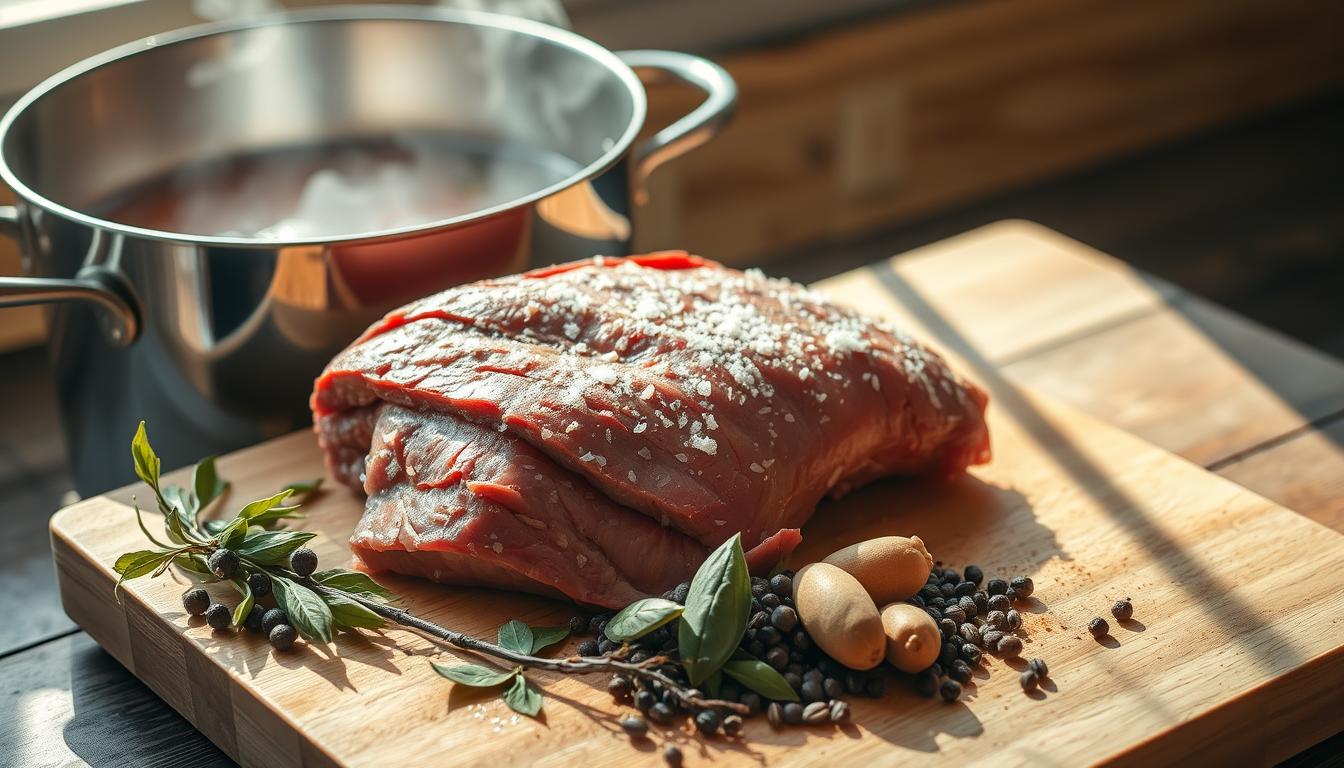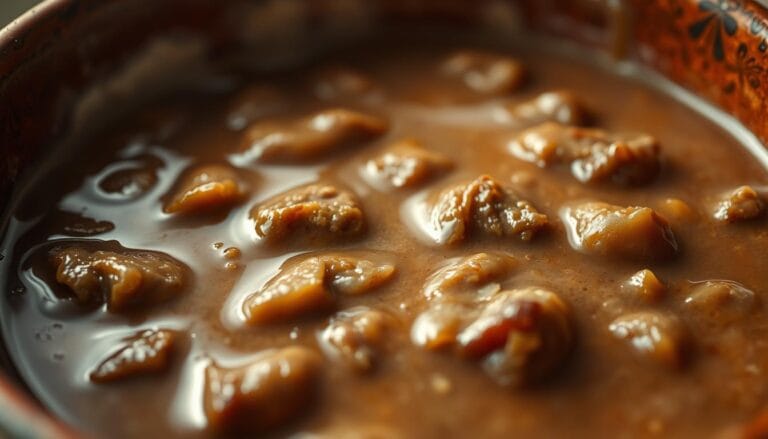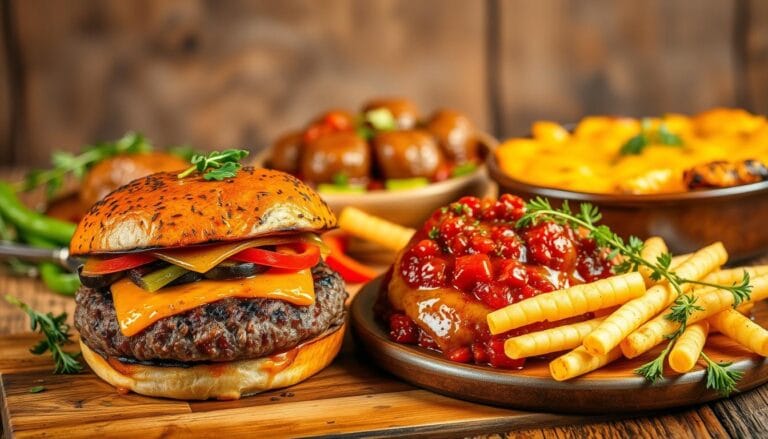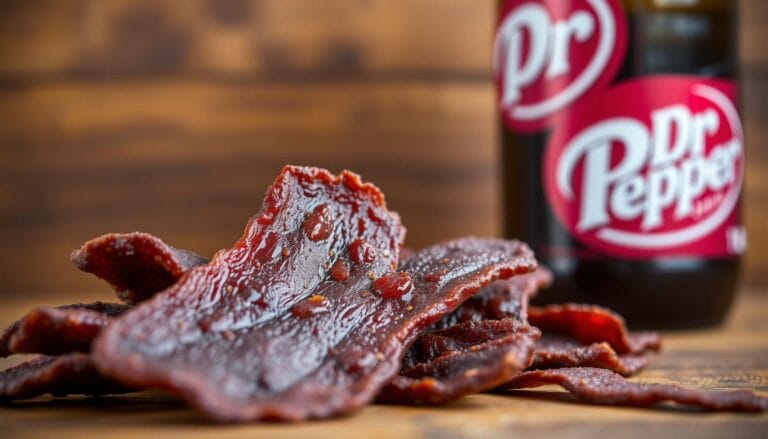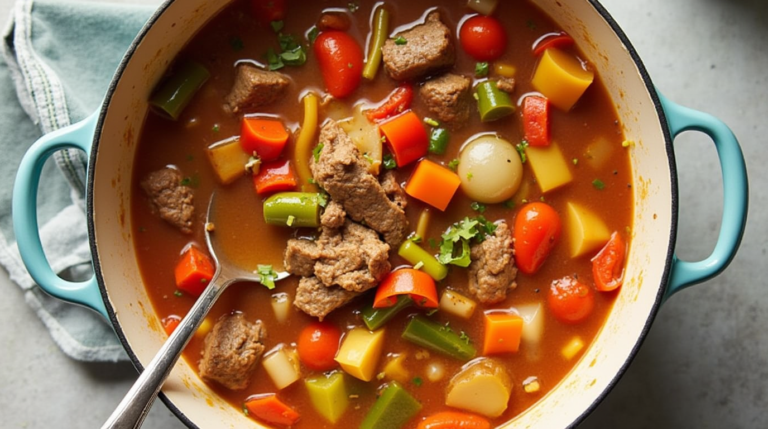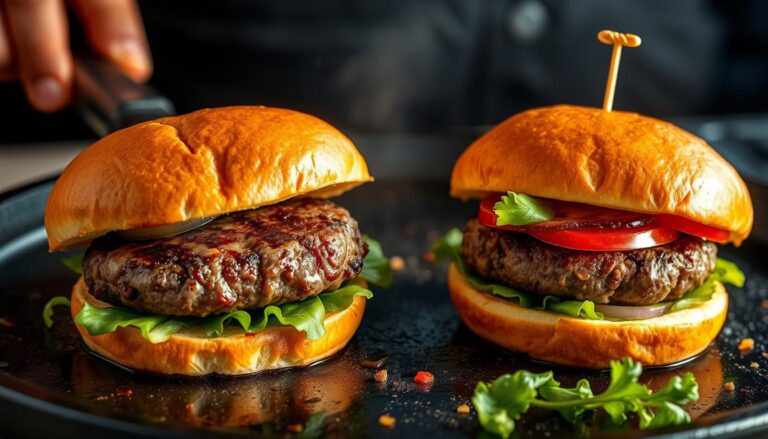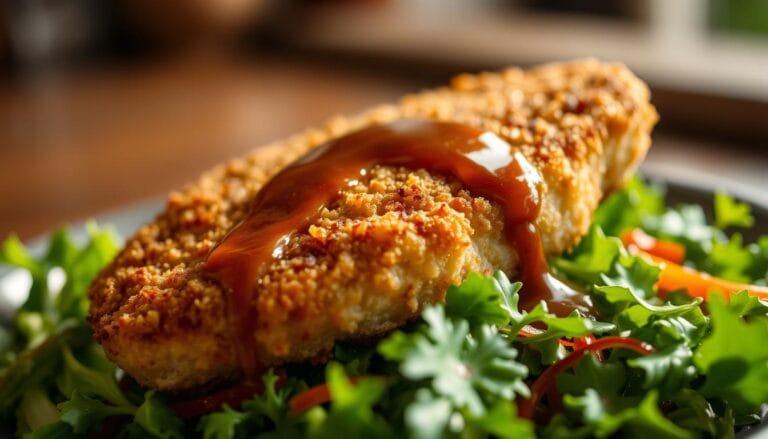How Is Corned Beef spices Made? Learn Process step-by-step
Every family gathering has that one dish that brings everyone together. For many Irish-American households, corned beef is that special centerpiece. It turns simple ingredients into a culinary tradition that tells a story of heritage and warmth.
Understanding how corned beef is made reveals a fascinating process of transformation. The art of creating this classic dish involves carefully selected corned beef spices. It also includes precise curing techniques and time-honored cooking methods passed down through generations.
Your journey into the world of corned beef will uncover the secrets behind its rich flavor and cultural significance. You’ll learn how to select the perfect beef brisket and master the intricate brining process. This skill connects you to a rich culinary tradition.
This classic dish, deeply rooted in Irish-American cuisine, is more than just a meal. It’s a celebration of flavor, technique, and cultural identity. It continues to bring families and communities together, especially during festive occasions like St. Patrick’s Day.
Table of Contents
Understanding Corned Beef: A Traditional Cured Meat
Corned beef brisket is a dish with deep roots in culture and history. It has a story that spans continents and generations. It started as a way to preserve meat and became a favorite in American cooking.
Origin of the Name “Corned”
The name “corned” comes from the salt used in curing. These corn-sized salt crystals helped preserve meat before refrigerators were common. When making homemade corned beef, these salt kernels are key to its flavor and texture.
Historical Significance in American Cuisine
Irish immigrants found a new food tradition in America. They discovered beef was cheaper and easier to find than in Ireland. They bought brisket from Jewish butchers, blending cultures.
- Beef was scarce and expensive in Ireland
- American markets offered abundant, affordable beef
- Irish immigrants developed new cooking traditions
Cultural Impact and Evolution
“Food is not just eating. It’s an experience.” – Guy Fieri
The story of corned beef is one of immigrant stories. It started as a way to preserve food and became a celebrated dish. It’s especially tied to St. Patrick’s Day in the United States.
| Period | Corned Beef Significance |
|---|---|
| Mid-1800s | Immigrant survival food |
| Early 1900s | Cultural adaptation |
| 21st Century | Culinary tradition |
Today, corned beef is still loved, showing resilience and cultural heritage. It’s a big part of American food history.
Essential Ingredients for Making Corned Beef
Making homemade corned beef starts with the right ingredients. Your spices and pickling blend are key to its flavor. This flavor makes the dish unforgettable.
To make perfect corned beef, you need a few important things:
- Beef brisket (4-5 pounds)
- Kosher salt
- Pink curing salt (5 teaspoons)
- Brown sugar
- Pickling spice blend
The pickling spice blend is crucial for authentic taste. Common spices include:
- Whole black peppercorns
- Mustard seeds
- Bay leaves
- Coriander seeds
- Allspice berries
- Crushed red pepper flakes
“The secret to great corned beef lies in the quality of your ingredients and the precision of your spice blend.”
For better slicing and less fat, pick a flat cut brisket. The right spices turn ordinary meat into a masterpiece.
| Ingredient | Quantity | Purpose |
|---|---|---|
| Beef Brisket | 4-5 pounds | Primary meat cut |
| Kosher Salt | 1/2 cup | Curing and seasoning |
| Pink Curing Salt | 5 teaspoons | Preservation and color |
| Brown Sugar | 1/4 cup | Balance and caramelization |
| Pickling Spice Blend | 2 tablespoons | Flavor enhancement |
Remember, exact measurements and top-notch ingredients are crucial. They make your corned beef dish a hit with everyone.
The Role of Pink Curing Salt in Corned Beef
Learning how to make corned beef means understanding pink curing salt’s role. This special ingredient turns a simple beef brisket into the tasty dish we all enjoy.
Pink curing salt, also known as Prague powder, is key for preserving and flavoring meat. It’s different from regular salt because it has sodium nitrite. This ingredient offers several benefits for making corned beef.
Why Pink Salt is Necessary
The main reasons for using curing salt in corned beef are:
- It stops bacteria from growing during curing
- It keeps the meat’s pink color
- It improves the meat’s taste
- It makes the meat last longer
Safety Considerations and Usage
Using pink curing salt requires careful attention. You should use 1 teaspoon (5 grams) for every 5 pounds of meat. Using too much can be dangerous, so always measure correctly.
| Meat Weight | Pink Curing Salt Amount |
|---|---|
| 5 pounds | 1 teaspoon |
| 10 pounds | 2 teaspoons |
Color and Preservation Benefits
“Pink curing salt is the secret ingredient that transforms ordinary beef into the vibrant, flavorful corned beef we all love.” – Culinary Expert
The sodium nitrite in pink curing salt does more than preserve meat. It also gives corned beef its distinctive pink color. During the 5 to 10-day brining process, the salt enhances both color and taste.
So, when you’re making corned beef, pink curing salt is not just optional. It’s essential for safety, flavor, and that classic look.
Selecting the Perfect Beef Brisket
Choosing the right corned beef brisket is key to a tasty dish. The quality of the brisket affects the dish’s texture and taste. It’s what makes your corned beef stand out.
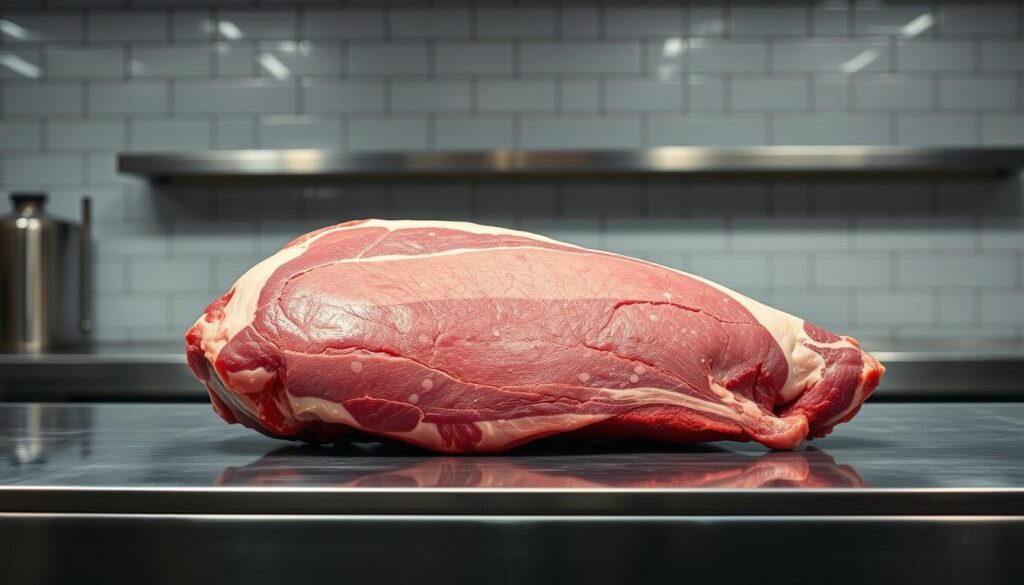
- Size matters: Look for a brisket between 3-5 pounds for optimal results
- Fat content is essential for flavor and moisture
- Choose a cut with consistent marbling
- Opt for USDA Choice or Prime grade beef when possible
Professional butchers suggest two main brisket cuts for corned beef:
- Flat Cut: Leaner and more uniform in shape
- Point Cut: More marbled with extra fat for richer flavor
“The secret to great corned beef is starting with a high-quality brisket.” – Professional Chef
Knowing about brisket’s special traits helps you choose wisely. This cut has lots of connective tissue. It needs slow cooking at 180°F to become tender. Your patience will turn a tough piece into a delicious treat.
Pro tip: When picking your corned beef brisket, look for meat with a bright, fresh color. Ask your local butcher for advice if you’re not sure about the best cut for your recipe.
Corned Beef Spices: Creating the Perfect Blend
Making the perfect corned beef spice blend is an art. It turns simple meat into a culinary masterpiece. Knowing the right spices can make your cooking stand out.
Traditional Pickling Spice Components
A classic pickling spice blend has a mix of aromatic ingredients. Your blend should include:
- Black peppercorns for bold, sharp flavor
- Mustard seeds adding a tangy kick
- Coriander seeds providing earthy undertones
- Allspice berries bringing warmth
- Bay leaves contributing subtle depth
- Cloves offering intense aromatics
Customizing Your Spice Mixture
Creating your own pickling spice blend lets you try new flavors. Most recipes make about 8 tablespoons. You only need 4 tablespoons for a typical corned beef dish.
“The secret to great corned beef lies in the harmony of spices you choose to blend.”
Measuring and Storage Tips
Here’s how to prepare your spice mix:
- Measure ingredients precisely
- Store in an airtight container
- Keep in a cool, dark place
- Use within 6 months for maximum flavor
Pro tip: For a 4-pound corned beef, use about 8 teaspoons of your spice blend. Try adding garlic powder or a pinch of red pepper flakes to make it your own.
The Brining Process: Time and Temperature
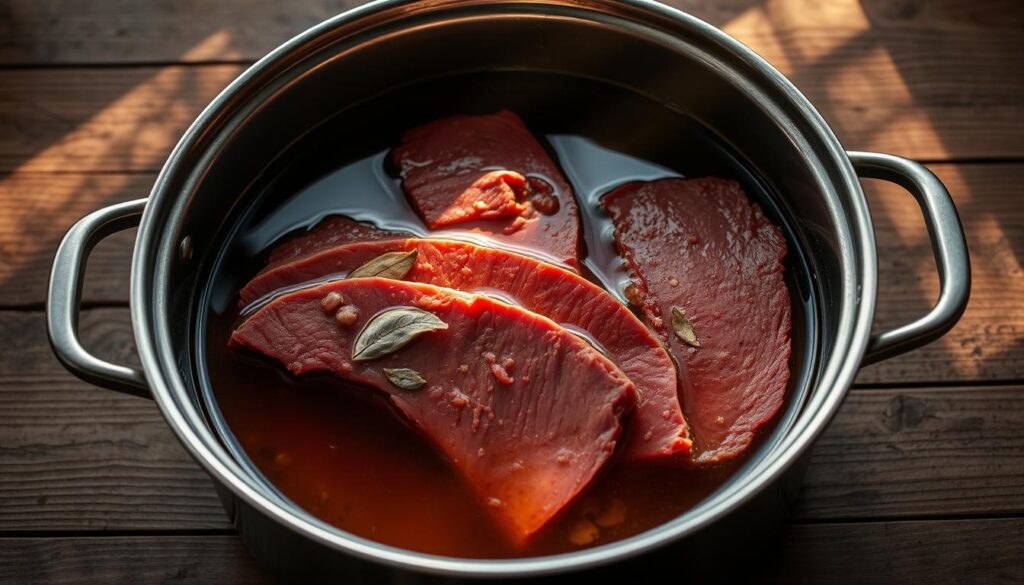
Learning to make corned beef at home starts with brining. This step turns regular beef into a tasty treat. It’s important to watch the time and temperature closely for safety and flavor.
Brining time is key for flavor. You’ll need to brine your beef for 5-7 days. Some places, like Katz’s, cure their meat for 3-4 weeks. Always keep the meat cold, at 38°F or lower, to stop bacteria.
“The secret to great corned beef is patience and precision in the brining process.” – Traditional Butcher’s Wisdom
Here’s what you need to know for brining your homemade corned beef:
- Refrigeration temperature: Below 38°F
- Typical brining duration: 5-7 days
- Maximum recommended brining time: 10 days
- Rinse meat thoroughly after brining to remove excess salt
Pink curing salt is crucial during brining. It keeps the meat safe and gives it that special color. Make sure to use the right amount for flavor and safety.
Pro tip: Use a non-reactive container like glass or ceramic. Make sure the meat is fully covered in brine. Rotate or flip the meat every day for even curing.
Cooking Methods and Techniques
Learning how corned beef is made opens up many cooking techniques. These methods can turn a brined brisket into a tasty meal. Each way has its own benefits for making homemade corned beef, ensuring it’s tender and full of flavor.
Cooking corned beef needs patience and the right technique. Different methods can help you get that perfect, tender texture:
Stovetop Simmering Method
The traditional stovetop method is a classic for cooking corned beef. Here’s how to do it:
- Place the corned beef in a large pot
- Cover completely with water
- Bring to a gentle boil
- Reduce heat and simmer for 3-4 hours
- Maintain water level throughout cooking
Slow Cooker Approach
The slow cooker method is great for those who want easy cooking:
- Place corned beef in slow cooker
- Add enough water to cover meat
- Cook on high for 4.5 hours
- Or cook on low for 8-9 hours
Instant Pot Instructions
Modern cooks love the speed of pressure cooking for homemade corned beef:
- Add 1 cup of water to Instant Pot
- Place corned beef on trivet
- Cook at high pressure for 70 minutes
- Allow natural pressure release
| Cooking Method | Time | Temperature |
|---|---|---|
| Stovetop | 3-4 hours | Gentle simmer |
| Slow Cooker | 4.5-9 hours | Low/High settings |
| Instant Pot | 70 minutes | High pressure |
Pro tip: Aim for an internal temperature of 180°F to 195°F for the best tenderness when making homemade corned beef.
Tips for Slicing and Serving
Learning to slice corned beef brisket right can make your meal amazing. A few simple techniques can help even beginners get great results.
“Patience and precision are the secret ingredients to perfectly sliced corned beef.” – Culinary Expert
Let your corned beef brisket rest for at least 15 minutes after cooking. This step is key for tender, juicy meat. It also makes slicing easier and keeps the meat moist.
Slicing Techniques
- Always slice against the grain of the meat
- Use a sharp carving knife for clean, even cuts
- Cut thin slices (approximately 1/4 inch thick)
- Hold the knife at a 90-degree angle for consistent results
The grain is the muscle fibers in your corned beef brisket. Cutting across these fibers makes the meat tender and easy to chew.
| Corned Beef Cut | Slicing Recommendation | Flavor Profile |
|---|---|---|
| Point Cut | More marbling, slightly harder to slice | Juicier and more flavorful |
| Flat Cut | Leaner, easier to slice uniformly | Cleaner presentation |
When serving, place your sliced corned beef brisket on a warm platter. Add boiled cabbage, roasted potatoes, and mustard for a delicious touch.
Storage and Leftover Ideas
Enjoying your homemade corned beef is just the start. Knowing how to store and use leftovers is key. It helps keep flavors fresh and food safe, while also offering new meal ideas.
Proper Storage Guidelines
Your homemade corned beef can stay fresh in the fridge for 3-4 days. Always store it in a sealed container, covered in its cooking liquid. This keeps it moist and prevents drying out.
- Refrigerate within 2 hours of cooking
- Store in shallow containers
- Keep meat covered with cooking liquid
- Maintain refrigerator temperature below 40°F
Creative Leftover Transformations
Turn your leftover corned beef into exciting dishes. These ideas will wow your family and cut down on waste. Here are some tasty options:
- Classic Reuben Sandwiches
- Corned Beef Hash with Eggs
- Loaded Breakfast Skillet
- Corned Beef Nachos
- Quick Breakfast Casserole
“Leftovers are the ultimate culinary canvas for creativity!” – Chef’s Wisdom
With these storage tips and recipe ideas, your homemade corned beef will keep delighting you in many ways.
Conclusion
Learning how to make corned beef is a journey into rich cultural traditions. You now know how to turn a simple brisket into a tasty dish. This dish honors Irish-American cooking traditions.
Making corned beef takes patience and detail. You’ve learned about brining, seasoning, and cooking. These skills will make your home cooking better.
Now you can try new spice blends and cooking ways. Quality ingredients and proper curing are key. With practice, you’ll make corned beef like a pro at home.
Start your culinary adventure with corned beef. Add your own twist to this classic dish. Every time you make it, you keep a tasty tradition alive.

